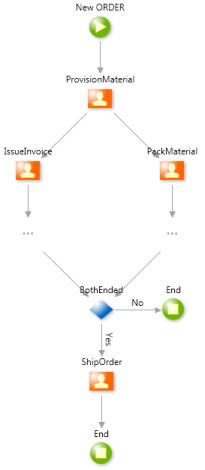
This product version has reached end of life and is no longer supported. Click here for the latest documentation.
Use this pattern to design multiple paths with activities executed in parallel: simply add outgoing connectors from the activity where the path splits into multiple paths.
When the process is executed, the sequence of activities in each parallel path is executed independently.
As an example, think of a process to handle orders that starts provisioning the ordered materials and then has two tasks performed in parallel: invoicing and packing materials.

To join parallel paths back into a single
path, that is executed only when all parallel paths are finished, simply
move the parallel paths into a new
![]() Process
and use a
Process
and use a
![]() Execute
Process
to execute that process.
Execute
Process
to execute that process.
When the process is executed, the
![]() Execute Process activity executes another process containing the parallel
activities: this process is only finished when all of its parallel activities
are finished.
Execute Process activity executes another process containing the parallel
activities: this process is only finished when all of its parallel activities
are finished.
As an example, think of a process to handle orders: provision materials, invoice and pack materials, and ship the order only when the order is completely packed.

To join parallel paths back into a single
path, that is executed once one of the parallel paths is finished, simply
move the parallel paths into a
![]() Process
and use a
Process
and use a
![]() Execute
Process
to execute that process. And, in the new process, set
the
Terminate
property of
Execute
Process
to execute that process. And, in the new process, set
the
Terminate
property of
![]() End
elements to 'Yes' to ensure
it terminates once a path ends.
End
elements to 'Yes' to ensure
it terminates once a path ends.
When the process is executed, the
![]() Execute Process activity executes another process containing the parallel
activities: this process terminates once one of its parallel activities
finishes.
Execute Process activity executes another process containing the parallel
activities: this process terminates once one of its parallel activities
finishes.
As an example, think of a process to handle orders: provision ordered materials either from the existing stock or from an external supplier, handle the order, and then send it.

There are other ways of joining parallel paths but they are anti-patterns, i.e., it is advisable not to use them because they are ineffective and/or counterproductive in practice:
Joining with no synchronization : the joined path is executed multiple times, once by each incoming parallel path, with no synchronization; there's no simple way of using information from each parallel path in the joined path.

Joining with
bad synchronization
: a
![]() Decision is used for
synchronizing parallel paths; the decision's logic is complex and not
exempt from concurrence problems, thus it may return wrong outcomes; there's
no simple way of using information from each parallel path in the joined
path.
Decision is used for
synchronizing parallel paths; the decision's logic is complex and not
exempt from concurrence problems, thus it may return wrong outcomes; there's
no simple way of using information from each parallel path in the joined
path.

See Also